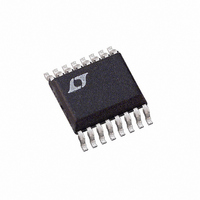LT6012ACGN Linear Technology, LT6012ACGN Datasheet - Page 11

LT6012ACGN
Manufacturer Part Number
LT6012ACGN
Description
IC OP AMP PREC QUAD R-R 16-SSOP
Manufacturer
Linear Technology
Datasheet
1.LT6011CS8PBF.pdf
(16 pages)
Specifications of LT6012ACGN
Amplifier Type
General Purpose
Number Of Circuits
4
Output Type
Rail-to-Rail
Slew Rate
0.11 V/µs
Gain Bandwidth Product
350kHz
Current - Input Bias
20pA
Voltage - Input Offset
35µV
Current - Supply
260µA
Current - Output / Channel
20mA
Voltage - Supply, Single/dual (±)
2.7 V ~ 36 V, ±1.35 V ~ 18 V
Operating Temperature
0°C ~ 70°C
Mounting Type
Surface Mount
Package / Case
16-SSOP
Lead Free Status / RoHS Status
Contains lead / RoHS non-compliant
-3db Bandwidth
-
Available stocks
Company
Part Number
Manufacturer
Quantity
Price
Company:
Part Number:
LT6012ACGN
Manufacturer:
LT
Quantity:
10 000
Part Number:
LT6012ACGN#PBF
Manufacturer:
LINEAR/凌特
Quantity:
20 000
Part Number:
LT6012ACGN#TRPBF
Manufacturer:
LINEAR/凌特
Quantity:
20 000
APPLICATIO S I FOR ATIO
SI PLIFIED SCHE ATIC
where e
impedance at the input, including the source impedance.
Capacitive Loads
The LT6011/LT6012 can drive capacitive loads up to 500pF
in unity gain. The capacitive load driving capability increases
as the amplifier is used in higher gain configurations. A small
series resistance between the output and the load further
increases the amount of capacitance that the amplifier can
drive.
W
n
–IN
+IN
V
V
+
–
= 14nV/√Hz , i
Figure 1. Some Op Amp Configurations Do Not Require Rail-to-Rail Inputs to Achieve Rail-to-Rail Outputs
500Ω
500Ω
R2
R1
V
REF
V
IN
U
Q7
Q3
R
INVERTING: A
OP AMP INPUTS DO NOT MOVE,
BUT ARE FIXED AT DC BIAS
POINT V
INPUT DOES NOT HAVE TO BE
RAIL-TO-RAIL
Q1
G
R3
n
D1
U
= 0.1pA/√Hz and R
REF
W
–
+
V
= –R
R
D2
F
F
W
/R
Q2
Q8
G
Q4
R4
(One Amplifier)
Q17
C
B
A
S
Q21
U
is the total
V
Q11
IN
B
A
NONINVERTING: A
INPUTS MOVE BY AS MUCH AS
V
MORE
INPUT MAY NOT HAVE TO BE
RAIL-TO-RAIL
IN
Q16
V
, BUT THE OUTPUT MOVES
REF
R
G
–
+
Q15
Q22
Rail-to-Rail Operation
The LT6011/LT6012 outputs can swing to within millivolts
of either supply rail, but the inputs can not. However, for
most op amp configurations, the inputs need to swing less
than the outputs. Figure 1 shows the basic op amp configu-
rations, lists what happens to the op amp inputs and speci-
fies whether or not the op amp must have rail-to-rail inputs.
Select a rail-to-rail input op amp only when really neces-
sary, because the input precision specifications are usually
inferior.
V
R
Q9
F
= 1 + R
Q5
F
/R
G
R5
C2
V
Q10
Q6
IN
Q12
NONINVERTING: A
INPUTS MOVE BY AS MUCH AS
OUTPUT
INPUT MUST BE RAIL-TO-RAIL
FOR OVERALL CIRCUIT
RAIL-TO-RAIL PERFORMANCE
R
C1
+
–
C1
D3
D4
D5
LT6011/LT6012
V
= 1
Q13
Q14
Q18
6011 F01
R6
C3
Q19
Q20
6011 SS
11
OUT
60112fb









